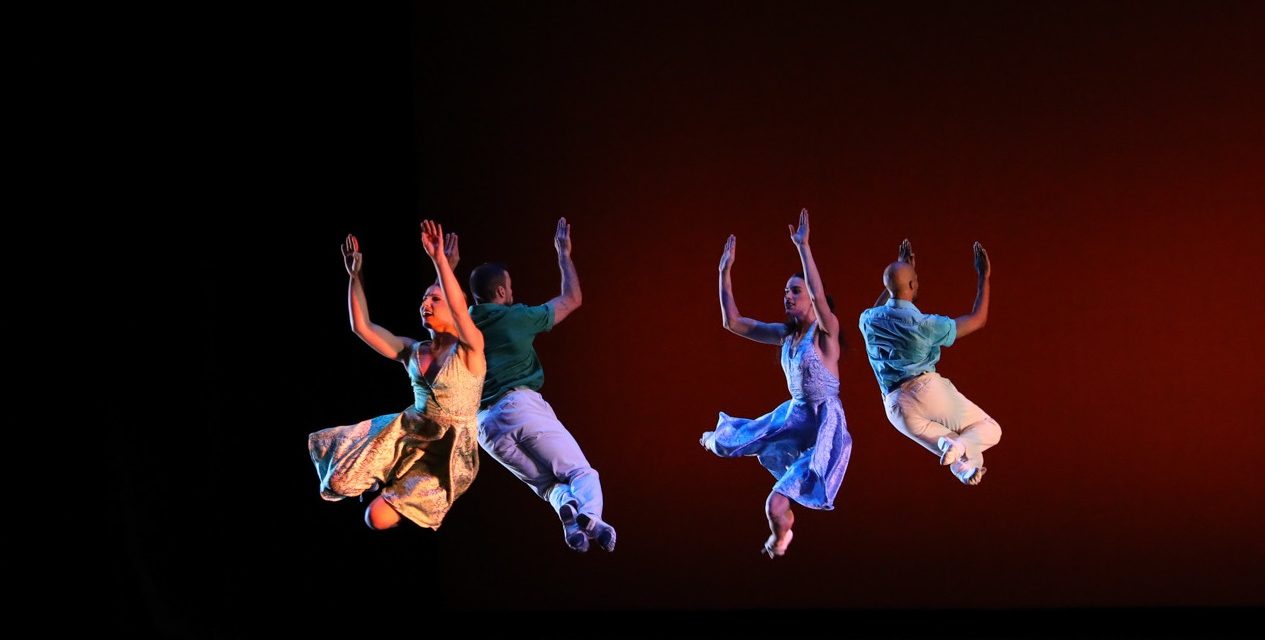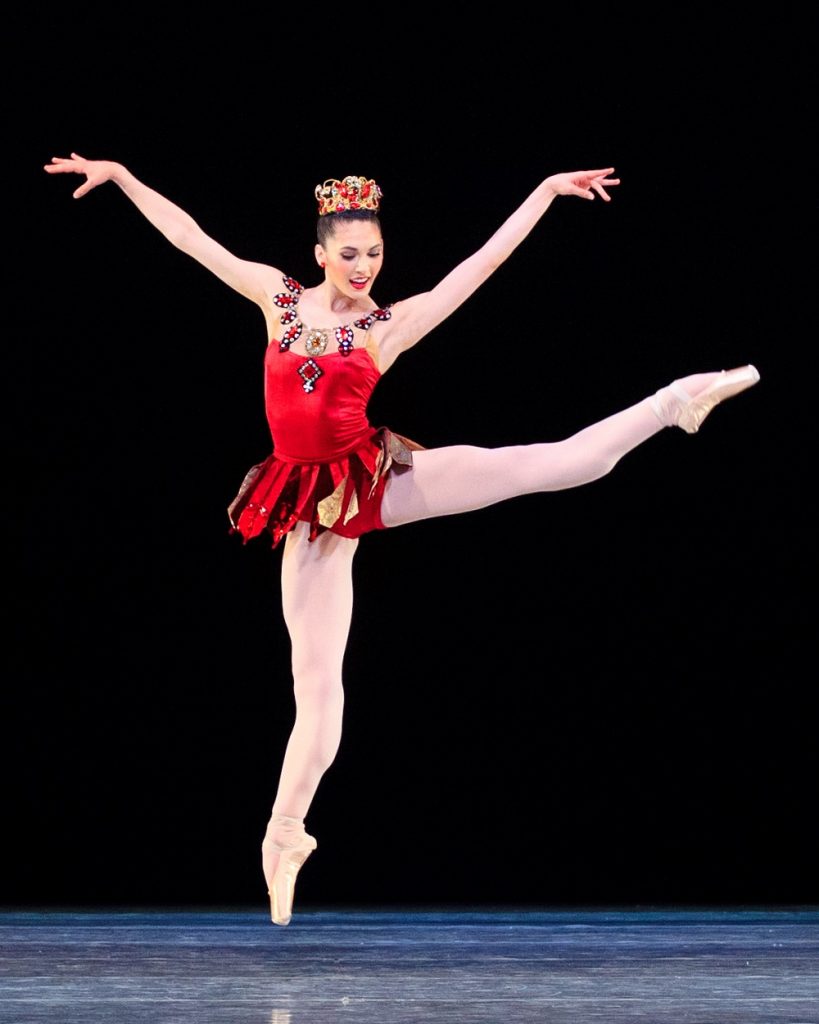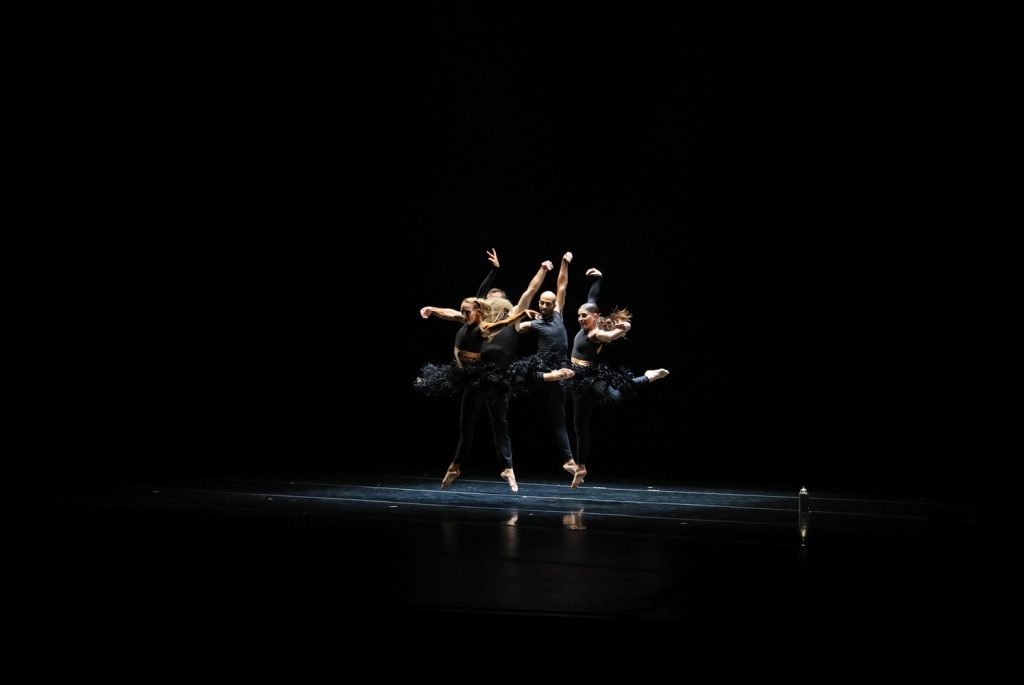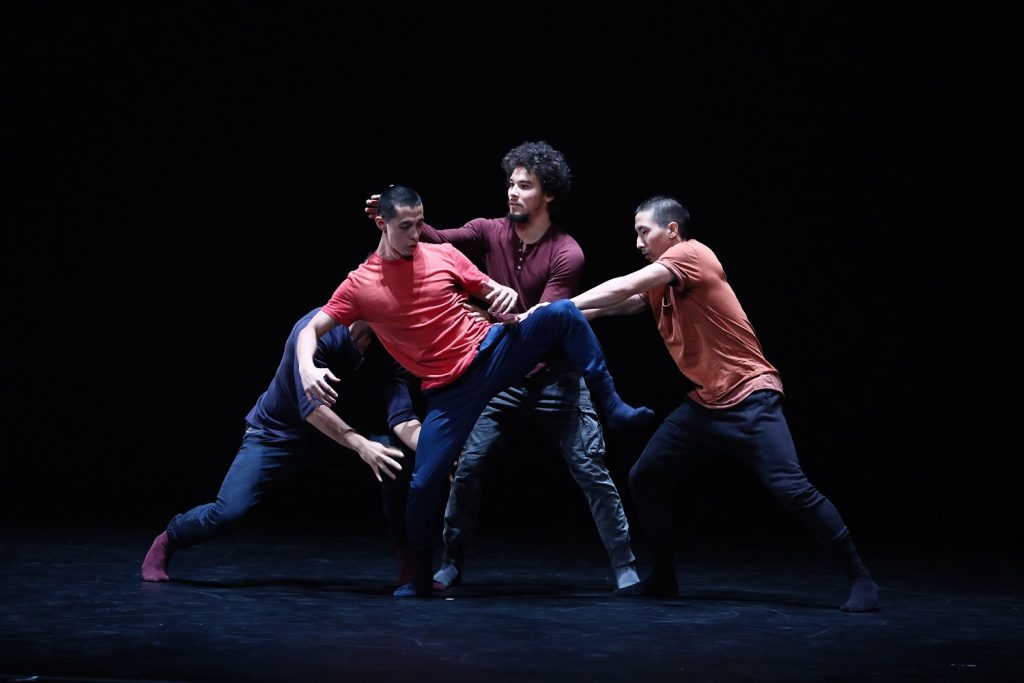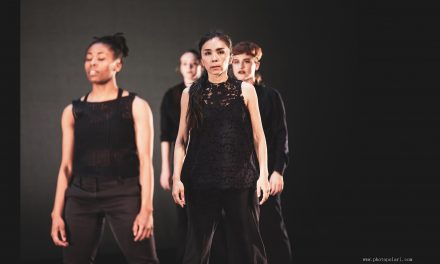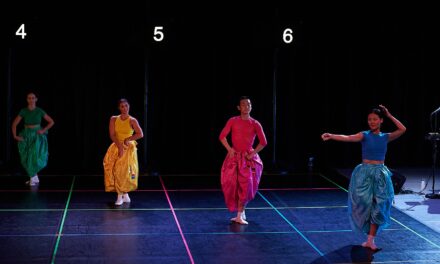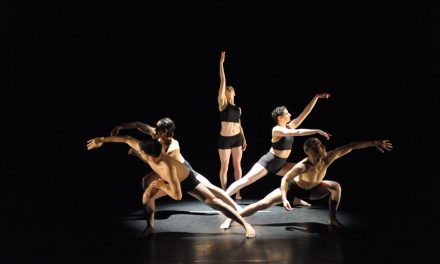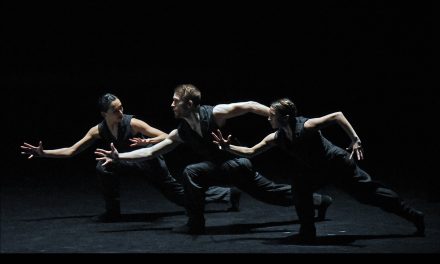Now in its 15th season, the Laguna Dance Festival is known for spotlighting interesting companies from all around the world. This year was no different. Their three-day program hosted by the Irvine Barclay Theatre featured a trio of North American ensembles, each having a very different approach to contemporary dance — a method that celebrates versatile performers and innovative choreography. In encouraging that sense of novelty, the festival annually awards five recipients looking to pursue a professional dance career or to study dance in higher education through their Young Artist Scholarship. The 2019 recipients were Dante Casarin, Ashley Lew, Nicole Denney, Zakary Sommer, and Miraya Lee.
The second night of the gala occurred on September 28 and featured RUBBERBAND, Ballet West, and Parsons Dance. Based in Montreal, RUBBERBAND opened the evening with an excerpt from Vic’s Mix — a compilation of artistic director Victor Quijada’s favorite picks from the company’s repertoire. The piece was a blend of comic and serious moments, classical and hip-hop moves.
Part one served as an introduction to the company’s style — very open body movements with well-synchronized cartwheels and turns. The seven dancers, Amara Barner, Jean Bui, Sydney McManus, Brontë Poiré-Prest, Jerimy Rivera, Ryan Taylor, and Paco Ziel took turns showcasing their individual style, followed by united groups, duets or trios that filled the stage with tall kicks and knee raises transitioning into smooth balletic turns.
The overall theme of the movement remained grounded in hip-hop, but the classical-based music (composed by Jasper Gahunia) helped to enhance each bounce and break dance–like flip. This was true particularly in the second half where each dancer took turns repeating those movements in a skit. Bui, McManus, and Ziel (who were strong standouts in the first section) humorously argued with the sound technician about playing the correct soundtrack for their solos. What started as a funny joke extended into a redundant spiel of interrupting one another. Thankfully the farce ended with all three joining forces to create an interesting creative collaboration. Altogether, the excitement of manipulating bodies to the music, while incorporating aspects of partnering won the day. Despite the overdrawn antics, Vic’s Mix was a wonderful taste of RUBBERBAND’s style and an impressive way to open the evening.
Salt Lake City’s Ballet West took the stage next with an excerpt from George Balanchine’s Jewels (1967), created for New York City Ballet. Performed by Beckanne Sisk and Hadriel Diniz to Igor Stravinsky’s Capriccio for Piano and Orchestra, Rubies Pas De Deux is from what many consider to be the first ever full-length abstract ballet, named more for costumes than anything else. Rubies red-clad duo (costumes designed by Karinska) had a structure reflective of the jazz era in which it was composed. The leg movements were more in line with traditional ballet, but the rest of the structure thrived on swinging hips, swaying torso movements and low dips that found Sisk falling into Diniz’s arms while crisscrossing her legs one at a time behind a bent knee. Repeated several times, this movement added a slinky sexuality to the dance — a sharp contrast to classical ballet’s more rigid architecture. The piano was quick, the transitions fast, and the chemistry between the couple was present throughout.
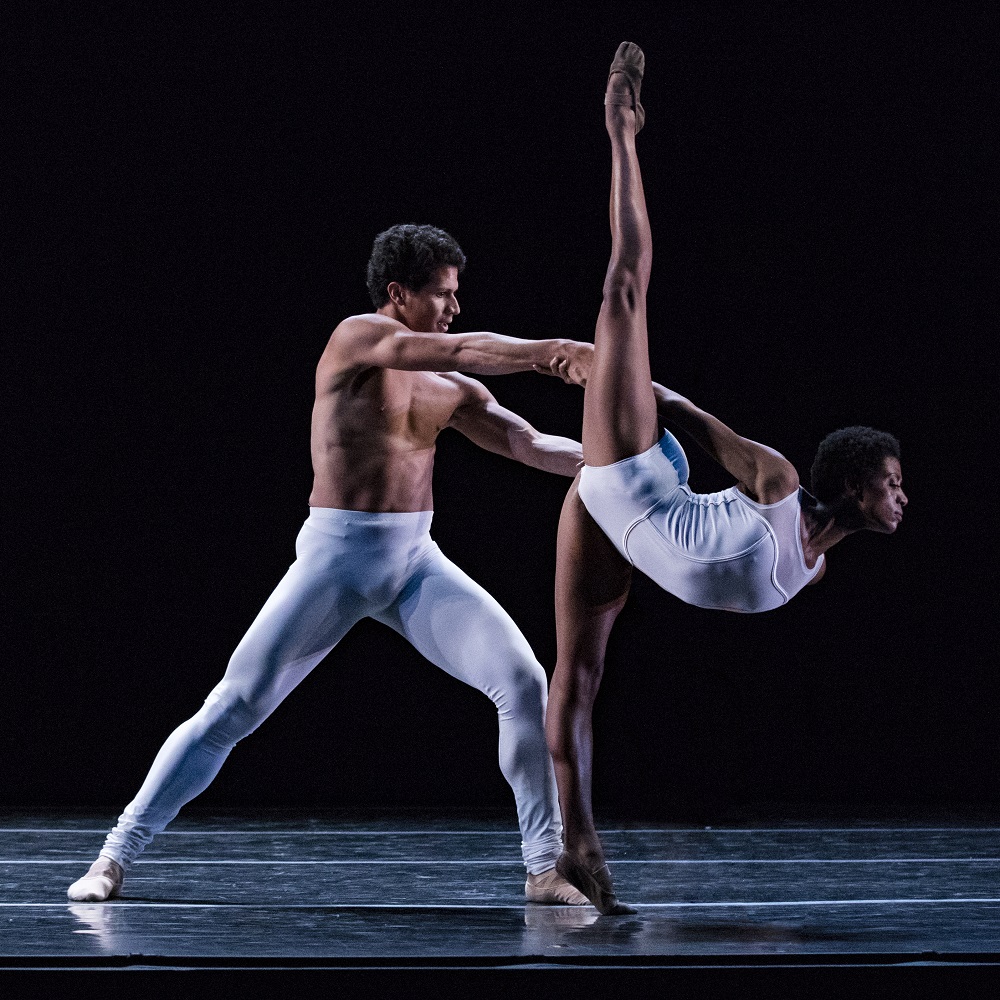
Ballet West – Hadriel Diniz and Katlyn Addison in África Guzmán’s “Sweet and Bitter” – Photo by Beau Pearson
Following intermission, Ballet West’s second work, Sweet and Bitter (2018) was entirely different, but retained traces of the characteristics seen in Rubies, predominantly high leg lifts and breath-holding extensions. Choreographed by África Guzmán to Ezio Bosso’s music, the piece showcased both emotions mentioned in the title; occurring separately in some parts of the dance but amalgamated in others. The ensemble of four men (Diniz, Chase O’Connell, Alexander MacFarlan, and Jordan Veit) and women (Sisk, Katlyn Addison, Jenna Rae Herrera, and Chelsea Keefer) performed primarily to elevated string music reminiscent of a panic scene in a thriller film. Even their slow and controlled movements conveying a sense of urgency and displayed in their facial features. The first section set the tone with all four men circling around lead artist Sisk, widening their stances and engulfing her with their energy as she swooned around them. Sisk partnered with Chase O’Connell, imitating the men’s creeping squats by spreading her thighs open as O’Connell spun her in a tight circle. With the full cast back onstage, their synchronized duets, became solos, then snippets of the women dancing in unison, followed by flashes of the men splitting off into duets. A feeling of calm occasionally emitted some stability into the frantic waves, but the erratic moments remained prominent. Sweet and Bitter showed another side to love unexplored in Rubies Pas De Deux.
New York City’s Parsons Dance performed during the first half of the show and as the grand finale. Caught (1982), choreographed by artistic director David Parsons was performed by the company’s strongest dancer — Zoey Anderson. Primarily a mystery, as indicated by the nonexistent information written in the program, this piece was the most original of the evening and staged in a way that I had not seen before. Set to Robert Fripp’s quintessentially ’80s electronic “Let The Power Fall” that sounded like a riff of the soundtrack from the popular Duffer Brothers’ TV series: Stranger Things. The dance began with quick box steps and bodybuilder-like poses interspersed with limp and vibrating limbs. Anderson retained her strength throughout, moving between spotlights with a confident stride. Eventually, the lighting gave way to a strobe light effect (designed by Parsons), which captured every one of her positions mid air, as though she were floating above the stage. Each jump in the dark was perfectly timed so that it appeared as if her feet never touched the ground. The light fully captured her bold strides and postures — her arms sometimes outstretched, hands sometimes on hips. Anderson completely dominated the stage, never once allowing the theatrics to feel gimmicky. The momentary glimpses into these freeze-framed portraits of dance encapsulated the art form’s ephemeral quality. You saw it or you missed it, for in a flash it was gone.
Eight Women (2019), choreographed by Trey McIntyre, was an equally energetic work with an octet of performers: Anderson, Katie Garcia, Sumire Ishige, Shawn Lesniak, Joan Rodriguez, Deidre Rogan, Daniel Sima, and Henry Steele. Costumed in skirts, the performers danced against a color-changing sunset to music performed by the Queen of Soul, Ms. Aretha Franklin. Hits ranged from Spanish Harlem and I Say a Little Prayer, to Natural Woman and The House That Jack Built, the most well-received by the audience. The movements’ constant flow split between fully ensemble-driven sections, and sudden solos and duets that remained cohesive throughout. The group’s constant drive took on a groovy and well-appreciated sway that did the music justice, and throughout, the dancers maintained a jazzy bounce to their step, ending the evening on a high note.
This year’s Laguna Dances Festival undoubtedly left me anticipating their upcoming season and directed me to explore the three companies’ full body of work as I await their return to Southern California.
To visit the Laguna Dance Festival website, click here.
Featured image: Parsons Dance – Photo by Mary Mallaney

